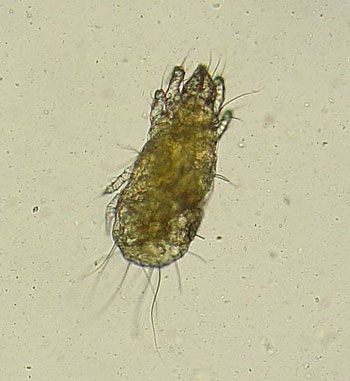Grain Mites Are Not Common in Homes
By Chris Williams on January 19, 2015.
We found a bag of rye flour that was full of very tiny bugs that my friend identified as grain mites. Are they going to infest our house? M. M., Atkinson, NH

100x magnification of a grain mite
Grain mites are not a problem that we often see in homes; they’re more of a bulk grain storage pest, so you might want to have a professional identify the pests. Grain mites are always associated with high humidity, and often with poor sanitation, old grain, or with packaged food products that are past their use-by date. The mites don’t like grain that is in good condition, so the simple fact that grain mites are infesting a food is a good clue that the food is old, probably moldy, and needs to be discarded anyway.
There are actually several different food mites including cheese mites, flour mites, mold mites, and grain mites. When grain mites are found in homes, it is usually in grain-based products that have been overlooked and left sitting for many weeks in a damp area. Grain mites can infest flours, rice, corn, cornmeal, cereals, and animal feed.
Moving “Brown Dust” May Be First Clue
These mites are so tiny that you really can’t see them well without magnification. Instead, what people first notice is the movement of the mites in the food product. If there are enough mites present, the food product can “sweat” and may have a minty smell.
Depending on where the infested food is located, you may have to do a major cleanout and treatment. But if the infestation is isolated to a single product, control can be much simpler. For example, if grain mites are infesting an old bag of dry dog food that has been sitting forgotten in the garage since last summer, simply discarding the bag and cleaning the surrounding area may eliminate the problem. If there are other stored foods near an infested product, you may want to toss them all or at least check them for mites.
No Dampness, No Mites
The key to getting rid of grain mites is to lower the humidity in the area through aeration, heat, or a dehumidifier. Mites need a relative humidity of greater than 55% (75-85% is ideal). Even if there are surviving grain mites after you’ve cleaned out your shelves, if the area is dry enough and the foods are not old or moldy, the mites will not be able to survive and re-infest.
If your food storage area remains humid and if you tend to hoard packaged foods, you could have an ongoing food mite infestation. If mites are a recurring problem, you need to rethink where and how you are storing your food products…and you need to give Colonial Pest a call.
For more on food mites, see these blogs:
By Joel Mills (Own work) [GFDL, CC-BY-SA-3.0, via Wikimedia Commons
Stay up-to-date with Colonial Pest’s email newsletter!